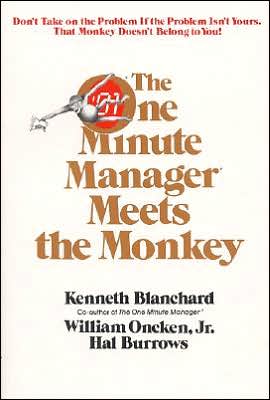It's Okay to Be the Boss: The Step-by-Step Guide to Becoming the Manager Your Employees Need
Do you feel you don't have enough time to manage your people?\ Do you avoid interacting with some employees because you hate the dreaded confrontations that often follow?\ Do you have some great employees you really cannot afford to lose?\ Do you secretly wish you could be more in control but don't know where to start?\ Managing people is harder and more high-pressure today than ever before. There's no room for downtime, waste, or inefficiency. You have to do more with less. And employees...
Search in google:
Do you feel you don't have enough time to manage your people? Do you avoid interacting with some employees because you hate the dreaded confrontations that often follow? Do you have some great employees you really cannot afford to lose? Do you secretly wish you could be more in control but don't know where to start? Managing people is harder and more high-pressure today than ever before. There's no room for downtime, waste, or inefficiency. You have to do more with less. And employees have become high maintenance. Not only are they more likely to disagree openly and push back, but they also won't work hard for vague promises of long-term rewards. They look to you--their immediate boss--to help them get what they need and want at work. How do you tackle this huge management challenge? If you are like most managers, you take a hands-off approach. You "empower" employees by leaving them alone, unless they really need you. After all, you don't want to "micromanage" them and don't have the time to hold every employee's hand. Of course, problems always come up and often snowball into bigger problems. In fact, you probably spend too much of your time solving problems and falling behind on your work . . . which leaves even less time for managing people . . . which opens the door for even more problems! In It's Okay to Be the Boss, Bruce Tulgan puts his finger on the biggest problem in corporate America--an undermanagement epidemic affecting managers at all levels of the organization and in all industries--and offers another way. His clear, step-by-step guide to becoming the strong manager employees need challenges bosses everywhere to spell out expectations, tell employees exactly what to do and how to do it, monitor and measure performance constantly, and correct failure quickly and reward success even more quickly. Now that's how you set employees up for success and help them earn what they need. Tulgan opens our eyes to the undisciplined workplace that is overwhelming managers and frustrating workers and invites bosses everywhere to accept the sacred responsibility of managing people. His message: It's okay to be the boss. Be a great one! Booklist “Hands-on management advice . . . excellent.”
Chapter One\ \ The Undermanagement Epidemic\ You walk into your local video store. On your way in, you notice two employees standing outside the door talking. One of them is lighting another cigarette; they've been there for a while. Inside, you see that the one employee behind the counter is too busy to help you find the DVD you want. When you find where the DVD is supposed to be, you realize the wrong DVD has been shelved behind the case. In frustration, you settle on another choice and go to the counter to check out. Of course, it takes forever to check out. As you leave, you silently curse the terrible service and think to yourself, "This place is terrible. They've got to start hiring better employees in this store!"\ It is tempting to look at this problem and blame the employees, or the entire enterprise. But the real cause is hiding behind the scenes: the manager. It is the manager's job to keep track of what's going on in that store and make sure that all the work is getting done on a consistent basis. How? By managing the people who work there! By telling the employees what to do and how to do it, by monitoring and measuring and documenting their performance, by solving problems quickly, and by singling people out for reward when they do a great job. That's what managing is.\ Managing is a sacred responsibility. If you are the boss, it is your responsibility to make sure everything goes well. You have to make sure all the work is getting done very well, very fast all day long. If you are the boss, employees look to you first when they need something, or when they want something, or when something is going wrong. If there's a problem, you are the solution.If you are the boss, you are the one everyone is counting on.\ But too many leaders, managers, and supervisors are failing to lead, manage, and supervise. They simply do not take charge on a day-to-day basis. They fail to spell out expectations every step of the way, track performance constantly, correct failure, and reward success. They are afraid to, or they don't want to, or they just don't know how to. All across the workplace, at all levels of organizations in every industry, there is a shocking and profound lack of daily guidance, direction, feedback, and support for employees. This is what I call "undermanagement"—the opposite of micromanagement.\ Show me a case of bad customer service—like the video store I described—and I'll show you a case of undermanagement. In fact, show me just about any problem in any workplace and I'll show you a case of undermanagement. Follow the trail into the workplace, behind the scenes: What went wrong with the response to Hurricane Katrina or the failure to bolster the New Orleans levees beforehand? What went wrong with the loss of personal data of millions of veterans at the VA? Data theft from credit card companies? Jayson Blair and the "made-up news" scandal at the New York Times? Dan Rather and the "National Guard" debacle? Other corporate stars gone wild? What went wrong at Enron? Arthur Andersen? Tyco? Medical mishaps? Pension deficits? Most airline delays? Whose job was it to make things go right? Whoever it is, that person has a boss. The boss is in charge. The boss is to blame. For what? For failing to make sure in the first place that the employees did their jobs properly.\ Undermanagement is costing organizations a fortune every day. It robs so many employees of the chance to have positive experiences in the workplace, reach greater success, and earn more of what they need and want. It causes managers to struggle and suffer and deliver suboptimal results. It sours dealings with vendors and customers. And it costs society in so many ways. Undermanagement is not a household word like micromanagement, but it should be because its impact makes micromanagement look like a molehill.\ The Undermanagement Epidemic: Hiding in Plain Sight\ Back in 1993, I started investigating the work attitudes of Generation X (born 19651977), those of my own generation who were then just entering the workforce. Companies started inviting me to speak at their conferences, train their managers, observe their operations, interview their leaders, conduct focus groups with their employees. At first, I was focused exclusively on generational issues. I'd go into a company, interview their young employees, and then hold a seminar with the leaders and managers to share what the young employees had to say. It was usually the same basic story: "Your young workers feel like they don't get enough direction from their managers. They want more training. They want more support and guidance. They want more coaching. They want more feedback." I didn't realize it then, but the Generation Xers were really telling me that they were being undermanaged.\ Like clockwork, one or more of the experienced workers would say something like "Son, welcome to the workplace. We all want someone to hold our hand and nobody is going to do that for you. When I started out, it was sink or swim every step of the way. If nobody told you what to do, you figured out what to do and you did it. Then you waited for your boss to notice you. No news was good news. If something went wrong, then you'd hear from your boss. Over time, you earn some seniority and the system takes care of you. It's no different now. These Generation Xers need to do what we all did. Pay your dues and climb the ladder." What these experienced workers were really telling me was that undermanagement had been the norm for as long as they could remember.\ Although undermanagement was hiding in plain sight right before my eyes, it took me years to really start tuning in to the problem. Throughout the 1990s, as the tech boom . . .\ It's Okay to Be the Boss\ The Step-by-Step Guide to Becoming the Manager Your Employees Need. Copyright © by Bruce Tulgan. Reprinted by permission of HarperCollins Publishers, Inc. All rights reserved. Available now wherever books are sold.
The Undermanagement Epidemic 1Get in the Habit of Managing Every Day 33Learn to Talk Like a Performance Coach 45Take It One Person at a Time 54Make Accountability a Real Process 73Tell People What to Do and How to Do It 89Track Performance Every Step of the Way 105Solve Small Problems before They Turn into Big Problems 124Do More for Some People and Less for Others 42Start Here 163Acknowledgments 187Index 191About the Author 197
\ Peter CappelliHands on management advice . . . an excellent book.\ \ \ \ \ General Dennis J. Reimer (Ret.)“If you want to be successful, I strongly recommend you do it the ‘Tulgan way.’”\ \ \ Mike Archer"Bruce Tulgan makes it safe again to be a hands-on manager."\ \ \ \ \ General"If you want to be successful, I strongly recommend you do it the ‘Tulgan way.’"\ \ \ \ \ General"If you want to be successful, I strongly recommend you do it the ‘Tulgan way.’"\ \ \ \ \ Booklist"Hands-on management advice . . . excellent."\ \ \ \ \ BusinessWeek SmallBiz"Small business owners . . . will find [Tulgan’s] advice valuable."\ \ \ \ \ Booklist“Hands-on management advice . . . excellent.”\ \ \ \ \ BusinessWeek SmallBiz“Small business owners . . . will find [Tulgan’s] advice valuable.”\ \








